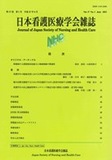Japanese
English
- 有料閲覧
- Abstract 文献概要
- 参考文献 Reference
要旨
【目的】1.看護学生の領域別臨地実習における学習活動の実態把握。2.領域別実習開始直後と終了時における学習活動自己評価の比較。【研究方法】A看護短期大学3年次生64名を対象とし、中山らが開発した学習活動自己評価尺度(SLAC)を使用し、領域別臨地実習開始直後および全実習終了後の2回にわたり調査した。調査票は35項目で構成され、「非常に当てはまる」を5点、「あまり当てはまらない」を1点の5件法にて調査した。分析方法は、各項目の平均点をt検定にて分析した。【結果・考察】実習開始直後および終了後の平均点の比較では、4.2点以上の高得点を示した項目は、実習開始直後は6項目であったが、終了後は16項目見られた。実習開始直後および終了後のいずれも得点が高かったのは、Ⅱのカテゴリーの2項目であった。実習開始直後の平均点が全体的に低かったカテゴリーは、Ⅳ、Ⅵのカテゴリーであった。看護学生は、実習全過程を通して、対象である患者を理解しようとする行動や、患者理解への態度については熱心に取り組もうとしている状況が伺える。しかし、他の看護師や教員から模範を見出そうとしたり、他者に助けを求める行動がとりづらくなっていることが推察され、相談をしやすい環境づくりが重要である。
[Objectives] 1. To elucidate the actual state of learning activities of nursing students in each training area. 2. To investigate the differences in learning activities immediately after starting and upon completion of the practicum in each area. [Methods] The subjects comprised 64 third-year nursing students at Nursing Junior College ‘A’ who were evaluated twice (once immediately after starting and once after completing training) using the Scale of Learning Activities in Nursing Clinical Practicum developed by Nakayama et al. The questionnaire was composed of 35 items, and scoring was based on a 5-point scale ranging from 1 point for ‘does not fit very well’ to 5 points for ‘fits perfectly’. The mean scores for each item were analyzed for significance using a t-test. [Results & Discussion] Comparison of the mean scores determined immediately after both starting and completing the practicum revealed that high scores of ≥4.2 were shown by 6 items immediately after starting, but by 16 items after completing training. Two items in Category II showed high scores at both evaluation time points. Mean scores after starting the practicum were lower overall in Categories IV and VI. The results indicate that, throughout the training process, the nursing students tried to earnestly understand patients. However, it can be speculated that the students look for models in other nurses and teachers, while finding it difficult to ask for advice from others. Thus, it is important to create an environment that enables consultation.
Copyright © 2015, Japan Society of Nursing and Health Care All rights reserved.


